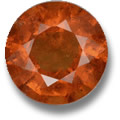Demantoid Garnet: The Dazzling Green Gem

About Demantoid Garnet
Ever seen a gem that sparkles brighter than a diamond? Meet demantoid garnet, the green superstar of the garnet family. This rare variety of andradite garnet gets its vivid green hue from chromium and ferric iron. Known for its exceptional brilliance, demantoid boasts a refractive index higher than ruby and sapphire, and its dispersion outshines even fine diamonds. That’s right - this gem has some serious fire!
First unearthed in Russia’s Ural Mountains in 1853, demantoid garnet is a relatively new discovery compared to other gems. Its rarity, especially in sizes over one carat, makes it a prized find. Russian demantoids are particularly famous for their golden “horsetail” inclusions - delicate, thread-like patterns caused by byssolite or chrysotile asbestos. These inclusions are like a gem’s fingerprint, adding character and value, especially in Russian stones. Want to dive deeper into the garnet family? Check out our Garnet Gemstone Information for a full overview.
Identifying Demantoid Garnet
Spotting a demantoid garnet is all about knowing its unique traits. As a calcium iron silicate, it has a specific gravity of 3.7 to 4.1 and a sky-high refractive index of 1.88 to 1.94 - making it one of the most brilliant gems out there. Its adamantine luster and dispersion give it a diamond-like sparkle that’s hard to miss.
Demantoids are typically small, with stones over two carats being exceptionally rare. Their green color, caused by chromium and ferric iron, sets them apart from similar gems like peridot, emerald, or tourmaline. Those iconic horsetail inclusions? They’re a dead giveaway for Russian demantoids, though not all have them. If you’re gem-hunting, these traits will help you pick out the real deal.
Origins and Sources
Demantoid garnet’s story begins in Russia’s Ural Mountains, where it was first discovered in 1853. For over a century, Russia was the only source, making these gems ultra-rare. Then, in 1996, Namibia’s Green Dragon Mine burst onto the scene, followed by finds in Madagascar in 2003. Today, deposits have also been reported in Afghanistan, Italy, Iran, China, Korea, Zaire, and the USA. Still, Russian demantoids remain the gold standard, especially those with horsetail inclusions. Curious about other rare garnets? Explore our Rare Garnets guide.
Buying Demantoid Garnet
Color
Demantoid garnet is always green, thanks to chromium, with ferric iron adding yellowish tones. Colors range from light, peridot-like green to deep, emerald-like shades. The more intense the green, the higher the value, though lighter stones often show off more of that dazzling fire.
Clarity and Luster
With its diamond-like luster and high transparency, demantoid is a showstopper. Inclusions are common, especially in stones over one carat, but eye-clean gems under a carat are out there. For Russian demantoids, those horsetail inclusions aren’t flaws - they’re a badge of honor!
Cut and Shape
Most demantoids are faceted to maximize their brilliance, with oval cuts being the go-to for preserving carat weight. You’ll also see rounds, pears, cushions, and fancy cuts. Diamond-cut stones are a favorite for showcasing that incredible fire.
Treatment
Good news: demantoid garnet is typically untreated. Rumors of low-heat treatments in some Russian stones surfaced in 2003, but tests couldn’t confirm it. What you see is what you get with this gem! For more tips on choosing garnets, check out our Garnet Buying Guide or browse our stock of loose Demantoid garnets right here.
Gemological Properties
| Chemical Formula | Ca3Fe2(SiO4) Calcium chromium silicate |
|---|---|
| Crystal Structure | Cubic - rhombic dodecahedron, icositetrahedron |
| Color | Yellow-green, green to emerald green |
| Hardness | 6.5 to 7.5 on the Mohs scale |
| Refractive Index | 1.888 to 1.94 |
| Density | 3.70 to 4.10 |
| Cleavage | Indistinct |
| Transparency | Transparent to opaque |
| Double Refraction | Normally none |
| Luster | Vitreous, diamond-like, adamantine |
| Fluorescence | Mostly none |
Curious about gemology terms? Check out a gemstone glossary for more details or explore All About Garnet for a broader look at this gem family.
Related Varieties

Garnets are a diverse bunch, with colors spanning red, green, blue, and more. Demantoid belongs to the andradite species, but the garnet family includes six mineral species and countless varieties. Popular ones include pyrope, almandine, rhodolite, spessartite, grossularite, tsavorite, and malaya garnet. Lesser-known varieties include hydrogrossular, color-change garnet, melanite, topazolite, uvarovite, Mali, hessonite, leuco, and umemite garnet. Be careful - garnets can look similar to chrysoberyl, alexandrite, tourmaline, spinel, or sapphire!
Explore Other Garnet Varieties
Mythology and Healing Properties
The name “garnet” comes from the Latin “granatus,” meaning “seed-like,” inspired by pomegranate seeds. Known for millennia, garnets have a rich history. The Greeks thought they protected kids from drowning and countered poison. In Christian and Hebrew traditions, garnet adorned Aaron’s breastplate and lit Noah’s ark. The Koran even says it lights up the fourth heaven! Learn more about these fascinating tales in our Garnet Meaning and Powers guide.
Demantoid is a traveler’s stone, believed to ward off evil and lift spirits. It’s tied to Aquarius, January birthdays, and second wedding anniversaries. Some claim it helps with arthritis, varicose veins, and more, but take these healing claims with a grain of salt - they’re not medically confirmed.
Disclaimer: Metaphysical and alternative healing properties are not confirmed advice. Consult a licensed medical practitioner for health concerns.
Jewelry Design Ideas
With its durability (6.5-7.5 on the Mohs scale) and stunning brilliance, demantoid garnet is a jeweler’s dream. It shines in rings, necklaces, bracelets, and pendants, often as an emerald alternative. Its rarity means you won’t find it in every store, but it’s perfect for unique anniversary bands or birthstone pieces. Pro tip: buy by size, not carat weight, as colored gems vary in density.
Care and Cleaning

Keep your demantoid sparkling with mild soap and warm water. Wipe with a soft cloth and rinse well to remove residue. Skip ultrasonic cleaners and steamers - they’re too harsh. Avoid bleach or hydrofluoric acid, and remove jewelry before sports to protect prongs. Store in a soft cloth or fabric-lined box to keep it safe.

